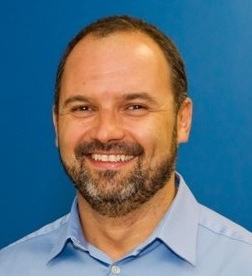Der Rückblick zum TEWI-Kolloquium von Dr. Oge Marques am 21-05-2013 beinhaltet die Videoaufzeichnung sowie die Folien:
Video
[iframe height=“350″ src=“http://video.aau.at/video.php?video=ftf_marques2.mp4″]
Slides
[iframe src=“http://www.slideshare.net/slideshow/embed_code/22430761″ width=“476″ height=“400″ frameborder=“0″ marginwidth=“0″ marginheight=“0″ scrolling=“no“]
Abstract:
There are many challenging problems in computer vision for which state-of-the-art solutions fall short of performing perfectly. The realization that many of these tasks are arduous for computers yet are relatively easy for humans has inspired many researchers to approach those problems from a human computation viewpoint, using methods that includecrowdsourcing and games – often called ‘games with a purpose’ (GWAPs). The talk discusses how we can use human computation (in general) and particularly games to help uncover hidden aspects of visual perception and use these findings to improve computer vision solutions to related problems. It particularly highlights two examples of our recent work on the topic:
1. Guess That Face (with Mathias Lux and Justyn Snyder, CHI 2013): a face recognition game that reverse engineers the human biological threshold for accurately recognizing blurred faces of celebrities under time-varying conditions.
2. Ask’N’Seek (with Vincent Charvillat and Axel Carlier, ECCV 2012): an object detection and labeling game that asks users to guess the location of a hidden region within an image with the help of semantic and topological clues and uses the information collected from game logs, combined with results from content analysis algorithms, to feed a machine learning algorithm that outputs the outline of the most relevant regions within the image and their names.
Short CV:
Oge Marques is an Associate Professor in the Department of Computer & Electrical Engineering and Computer Science at Florida Atlantic University (FAU) (Boca Raton, Florida). He received his Ph.D. in Computer Engineering from FAU in 2001. He has more than 20 years of teaching and research experience in the fields of image processing and computer vision, in different countries (U.S., Austria, Brazil, Netherlands, Spain, France, and India), languages (English,Portuguese,Spanish), and capacities.He is the (co-) author of more than 50 refereed journal and conference papers and several books in these topics, including the textbook Practical Image and Video Processing UsingMATLAB (Wiley, 2011). His research interests are in the area of intelligent processing of visual information, which combines the fields of image processing, computer vision, image retrieval, machine learning, serious games, and human visual perception. He is particularly interested in the combination of human computation and machine learning techniques to solve computer vision problems.
He is a senior member of both the ACM and IEEE, and a member of the IEEE Computer Society, IEEE Education Society, IEEE Signal Processing Society, and the honor societies of Tau Beta Pi, Sigma Xi, Phi Kappa Phi, and Upsilon Pi Epsilon.
 Abstract: Automatic visual information retrieval methods are typically easy to use but have well-known issues, such as the semantic gap or the usability gap. Pure navigation-based methods on the other hand are usually too tedious to use, especially for large multimedia data archives. In this talk I will discuss visual content browsing, a content-based exploratory search approach that integrates methods of automatic retrieval and interactive search. I will explain how visual content browsing can help us to overcome the shortcomings of automatic image and video retrieval. Special emphasis will be put on the interactive part, although content analysis methods will be introduced as well. Furthermore, I will talk about the evaluation of visual content browsing tools, mention related issues and introduce the Video Browser Showdown, which is an annual competition to evaluate such tools. The talk will be concluded with an outlook of future opportunities and challenges of visual content browsing.
Abstract: Automatic visual information retrieval methods are typically easy to use but have well-known issues, such as the semantic gap or the usability gap. Pure navigation-based methods on the other hand are usually too tedious to use, especially for large multimedia data archives. In this talk I will discuss visual content browsing, a content-based exploratory search approach that integrates methods of automatic retrieval and interactive search. I will explain how visual content browsing can help us to overcome the shortcomings of automatic image and video retrieval. Special emphasis will be put on the interactive part, although content analysis methods will be introduced as well. Furthermore, I will talk about the evaluation of visual content browsing tools, mention related issues and introduce the Video Browser Showdown, which is an annual competition to evaluate such tools. The talk will be concluded with an outlook of future opportunities and challenges of visual content browsing.
 Abstract: Through three prominent combinatorial optimization problems (graph coloring, maximum cut, ordering) we will explain modelling techniques using semidefinite programming (as opposed to linear programming). We will derive relaxations that yield tight bounds and give rise to heuristics to obtain high-quality feasible solutions. We demonstrate how to combine these ingredients within a branch-and-bound framework, thus obtaining an exact solution method.
Abstract: Through three prominent combinatorial optimization problems (graph coloring, maximum cut, ordering) we will explain modelling techniques using semidefinite programming (as opposed to linear programming). We will derive relaxations that yield tight bounds and give rise to heuristics to obtain high-quality feasible solutions. We demonstrate how to combine these ingredients within a branch-and-bound framework, thus obtaining an exact solution method.

